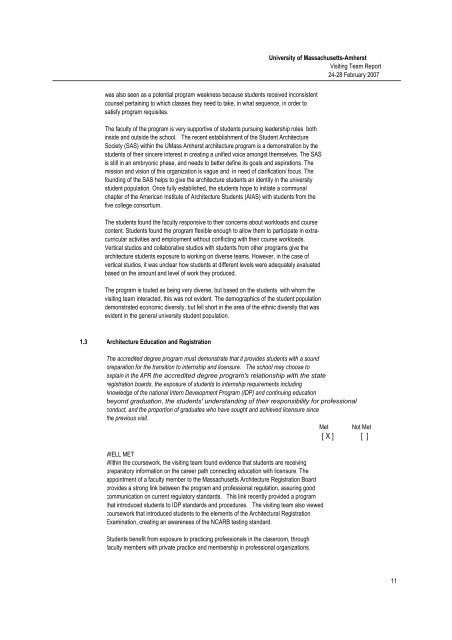architecture program report - University of Massachusetts Amherst
architecture program report - University of Massachusetts Amherst
architecture program report - University of Massachusetts Amherst
You also want an ePaper? Increase the reach of your titles
YUMPU automatically turns print PDFs into web optimized ePapers that Google loves.
was also seen as a potential <strong>program</strong> weakness because students received inconsistent<br />
counsel pertaining to which classes they need to take, in what sequence, in order to<br />
satisfy <strong>program</strong> requisites.<br />
The faculty <strong>of</strong> the <strong>program</strong> is very supportive <strong>of</strong> students pursuing leadership roles both<br />
inside and outside the school. The recent establishment <strong>of</strong> the Student Architecture<br />
Society (SAS) within the UMass <strong>Amherst</strong> <strong>architecture</strong> <strong>program</strong> is a demonstration by the<br />
students <strong>of</strong> their sincere interest in creating a unified voice amongst themselves. The SAS<br />
is still in an embryonic phase, and needs to better define its goals and aspirations. The<br />
mission and vision <strong>of</strong> this organization is vague and in need <strong>of</strong> clarification/ focus. The<br />
founding <strong>of</strong> the SAS helps to give the <strong>architecture</strong> students an identity in the university<br />
student population. Once fully established, the students hope to initiate a communal<br />
chapter <strong>of</strong> the American Institute <strong>of</strong> Architecture Students (AIAS) with students from the<br />
five college consortium.<br />
The students found the faculty responsive to their concerns about workloads and course<br />
content. Students found the <strong>program</strong> flexible enough to allow them to participate in extra-<br />
curricular activities and employment without conflicting with their course workloads.<br />
Vertical studios and collaborative studios with students from other <strong>program</strong>s give the<br />
<strong>architecture</strong> students exposure to working on diverse teams. However, in the case <strong>of</strong><br />
vertical studios, it was unclear how students at different levels were adequately evaluated<br />
based on the amount and level <strong>of</strong> work they produced.<br />
The <strong>program</strong> is touted as being very diverse, but based on the students with whom the<br />
visiting team interacted, this was not evident. The demographics <strong>of</strong> the student population<br />
demonstrated economic diversity, but fell short in the area <strong>of</strong> the ethnic diversity that was<br />
evident in the general university student population.<br />
1.3 Architecture Education and Registration<br />
<strong>University</strong> <strong>of</strong> <strong>Massachusetts</strong>-<strong>Amherst</strong><br />
Visiting Team Report<br />
24-28 February 2007<br />
The accredited degree <strong>program</strong> must demonstrate that it provides students with a sound<br />
preparation for the transition to internship and licensure. The school may choose to<br />
explain in the APR the accredited degree <strong>program</strong>'s relationship with the state<br />
registration boards, the exposure <strong>of</strong> students to internship requirements including<br />
knowledge <strong>of</strong> the national Intern Development Program (IDP) and continuing education<br />
beyond graduation, the students' understanding <strong>of</strong> their responsibility for pr<strong>of</strong>essional<br />
conduct, and the proportion <strong>of</strong> graduates who have sought and achieved licensure since<br />
the previous visit.<br />
WELL MET<br />
Within the coursework, the visiting team found evidence that students are receiving<br />
preparatory information on the career path connecting education with licensure. The<br />
appointment <strong>of</strong> a faculty member to the <strong>Massachusetts</strong> Architecture Registration Board<br />
provides a strong link between the <strong>program</strong> and pr<strong>of</strong>essional regulation, assuring good<br />
communication on current regulatory standards. This link recently provided a <strong>program</strong><br />
that introduced students to IDP standards and procedures. The visiting team also viewed<br />
coursework that introduced students to the elements <strong>of</strong> the Architectural Registration<br />
Examination, creating an awareness <strong>of</strong> the NCARB testing standard.<br />
Students benefit from exposure to practicing pr<strong>of</strong>essionals in the classroom, through<br />
faculty members with private practice and membership in pr<strong>of</strong>essional organizations.<br />
Met<br />
[ X ]<br />
Not Met<br />
[ ]<br />
11<br />
10<br />
7

















